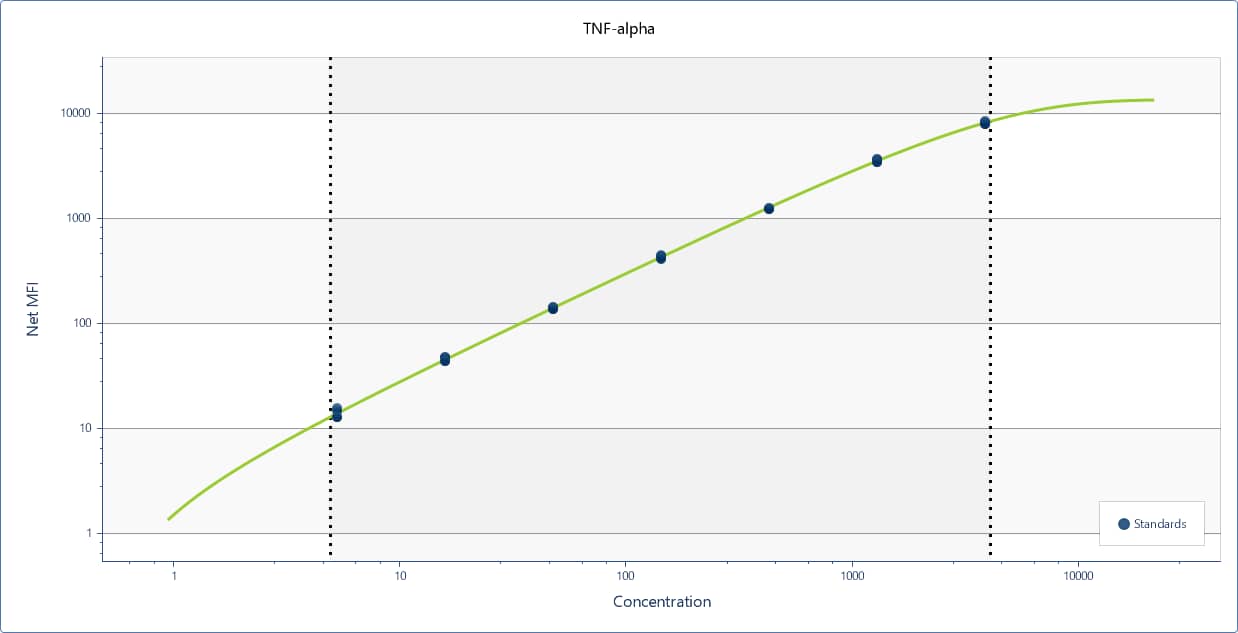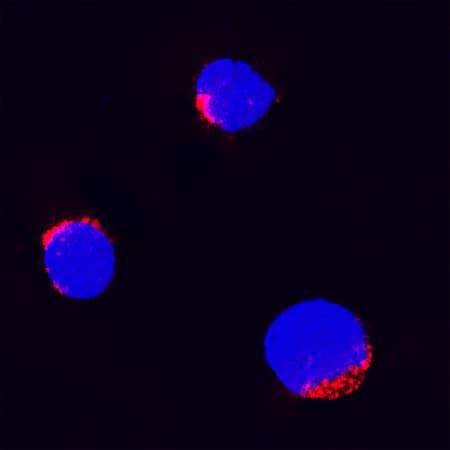TNF-alpha Products
TNF-alpha (Tumor necrosis factor alpha) plays a central role in inflammation, immune system development, apoptosis, and lipid metabolism. TNF-alpha was first identified as a cytotoxic factor produced by macrophages capable of killing mouse tumor cells. It is the prototypic ligand and along with Lymphotoxin-alpha, were identified as the first members of the TNF superfamily. Active TNF-alpha and other members of the TNF superfamily exist as a homotrimer with high structural homology. Receptor binding occurs at the interface of two TNF-alpha monomers. And receptor activation occurs when all three monomer interfaces are engaged with a receptor. For TNF-alpha, receptor binding and activation occurs through TNF R1 or TNF RII, and subsequently leads to activation of NF-kB or MAPK signaling pathways. Another pathway that TNF-alpha can activate utilizes the death domain of TNF RI to induce apoptosis. TNF-alpha promotes the inflammatory response largely through NF-kB signaling, and inhibition of TNF-alpha has proven successful in treating many autoimmune disorders. TNF-alpha is also present on the cell surface as membrane-bound TNF-alpha can induce the lysis of neighboring tumor cells and virus infected cells. TNF-alpha protein is translated as a type II transmembrane protein containing an N-terminal transmembrane domain. The soluble cytokine is released from its cell-anchoring TM domain by proteolytic processing by metalloproteases.
24 results for "TNF-alpha" in Products
24 results for "TNF-alpha" in Products
TNF-alpha Products
TNF-alpha (Tumor necrosis factor alpha) plays a central role in inflammation, immune system development, apoptosis, and lipid metabolism. TNF-alpha was first identified as a cytotoxic factor produced by macrophages capable of killing mouse tumor cells. It is the prototypic ligand and along with Lymphotoxin-alpha, were identified as the first members of the TNF superfamily. Active TNF-alpha and other members of the TNF superfamily exist as a homotrimer with high structural homology. Receptor binding occurs at the interface of two TNF-alpha monomers. And receptor activation occurs when all three monomer interfaces are engaged with a receptor. For TNF-alpha, receptor binding and activation occurs through TNF R1 or TNF RII, and subsequently leads to activation of NF-kB or MAPK signaling pathways. Another pathway that TNF-alpha can activate utilizes the death domain of TNF RI to induce apoptosis. TNF-alpha promotes the inflammatory response largely through NF-kB signaling, and inhibition of TNF-alpha has proven successful in treating many autoimmune disorders. TNF-alpha is also present on the cell surface as membrane-bound TNF-alpha can induce the lysis of neighboring tumor cells and virus infected cells. TNF-alpha protein is translated as a type II transmembrane protein containing an N-terminal transmembrane domain. The soluble cytokine is released from its cell-anchoring TM domain by proteolytic processing by metalloproteases.
| Sensitivity: | 7.21 pg/mL |
| Applications: | ELISA |
| Assay Range: | 10.9 - 700 pg/mL (Cell Culture Supernates, Serum, EDTA Plasma, Heparin Plasma) |
| Assay Range: | 31.2 - 2,000 pg/mL |
| Applications: | ELISA |
Analyzed by SEC-MALS
| Source: | E. coli |
| Accession #: | P06804 |
| Applications: | BA |
| Sensitivity: | 5 pg/mL |
| Applications: | ELISA |
| Assay Range: | 12.5 - 800 pg/mL (Cell Culture Supernates, Serum, EDTA Plasma, Heparin Plasma) |
| Assay Range: | 15.6 - 1,000 pg/mL |
| Applications: | ELISA |
| Reactivity: | Human, Mouse, Rat, Canine, Fish, +1 More |
| Details: | Rabbit IgG Polyclonal |
| Applications: | IHC, WB, ICC/IF, Flow |
| Sensitivity: | 5 pg/mL |
| Applications: | ELISA |
| Assay Range: | 23.4 - 1,500 pg/mL (Cell Culture Supernates, Serum, EDTA Plasma, Heparin Plasma) |
| Reactivity: | Human |
| Details: | Goat IgG Polyclonal |
| Applications: | WB, ICC |
| Source: | E. coli |
| Accession #: | P16599 |
| Applications: | BA |
| Reactivity: | Human |
| Details: | Goat IgG Polyclonal |
| Applications: | WB, ICC, Neut |
| Reactivity: | Human, Mouse, Rat, Primate, Chicken, +1 More |
| Details: | Rabbit Serum Polyclonal |
| Applications: | IHC, WB, ICC/IF, ELISA, B/N |
| Sensitivity: | 4.2 pg/mL |
| Applications: | ELISA |
| Assay Range: | 7.8 - 500 pg/mL (Cell Culture Supernates, Serum, EDTA Plasma, Heparin Plasma) |
| Reactivity: | Mouse |
| Details: | Goat IgG Polyclonal |
| Applications: | WB |
Luminex High Performance Assays go through rigorous development, validation, and quality control testing to ensure you are getting the best performance out of your multiplex assay. Panels are customizable so you can order a selection of the analytes or the entire panel.
| Reactivity: | Rat |
| Details: | Mouse IgG1 Monoclonal Clone #45418 |
| Applications: | WB, Neut |
| Assay Range: | 31.2 - 2,000 pg/mL |
| Applications: | ELISA |
| Source: | E. coli |
| Accession #: | P23563 |
| Applications: | BA |
Intended for preclinical researchers who may transition to GMP TNF-alpha for their clinical work
| Source: | E. coli |
| Accession #: | P01375.1 |
| Applications: | BA |
| Reactivity: | Rat |
| Details: | Goat IgG Polyclonal |
| Applications: | WB |
| Reactivity: | Human |
| Details: | Rabbit IgG Polyclonal |
| Applications: | IHC, WB, ELISA, ICC/IF |
| Reactivity: | Bovine |
| Details: | Goat IgG Polyclonal |
| Applications: | WB, ICC |
| Reactivity: | Porcine |
| Details: | Mouse IgG1 Monoclonal Clone #103304 |
| Reactivity: | Porcine |
| Details: | Mouse IgG1 Monoclonal Clone #103302 |
Analyzed by SEC-MALS
| Source: | E. coli |
| Accession #: | P01375 |
| Applications: | BA |







![Western Blot: TNF-alpha AntibodyBSA Free [NBP1-19532] Western Blot: TNF-alpha AntibodyBSA Free [NBP1-19532]](https://resources.bio-techne.com/images/products/TNF-alpha-Antibody-Western-Blot-NBP1-19532-img0007.jpg)




![Western Blot: TNF-alpha AntibodyAzide Free [NB600-587] Western Blot: TNF-alpha AntibodyAzide Free [NB600-587]](https://resources.bio-techne.com/images/products/TNF-alpha-Antibody---Azide-Free-Western-Blot-NB600-587-img0012.jpg)





![Western Blot: TNF-alpha Antibody [NBP2-44062] Western Blot: TNF-alpha Antibody [NBP2-44062]](https://resources.bio-techne.com/images/products/TNF-alpha)

